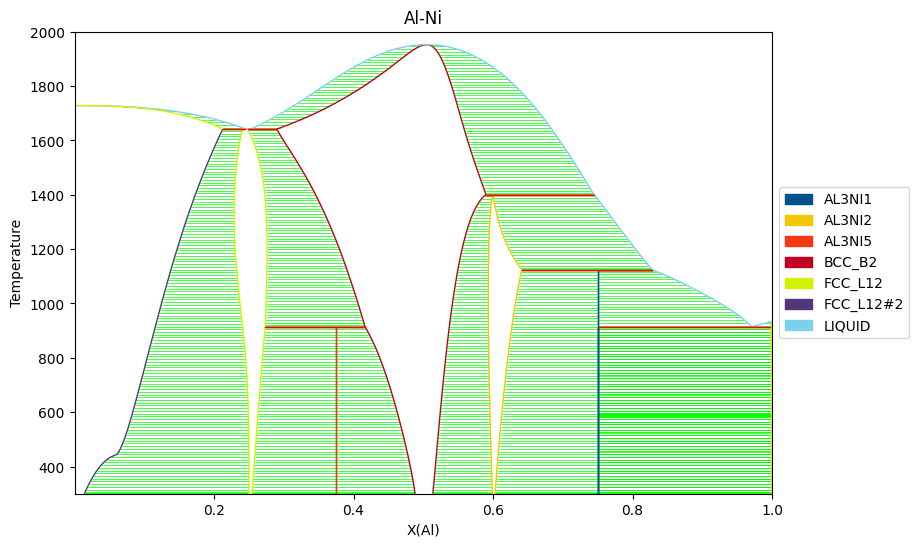 pycalphad: Computational Thermodynamics¶
pycalphad: Computational Thermodynamics¶

pycalphad is a Python library for computational thermodynamics using the CALPHAD method.
The latest development version of the source code can be found on GitHub. The newest stable version can be found on PyPI.
- Install pycalphad
- Examples
- Plotting Isobaric Binary Phase Diagrams with
binplot - Plotting Ternary Phase Diagrams and Using Triangular Axes
- Plot energy curves for several phases
- Driving force calculation
- Calculate T0 (t-zero) as a function of composition
- Calculations with Reference States
- Equilibrium Properties and Partial Ordering (Al-Fe and Al-Ni)
- Heat Capacity of Cementite (\(Fe_3C\))
- Plotting Isobaric Binary Phase Diagrams with
- Advanced Examples
- Exploring
calculateandequilibriumxarray Datasets - Calculating Energy Surfaces [Legacy Method]
- Special
_MIXReference State - Calculations at specific site fractions
- Phases with Electrically Charged Species
- Calculate and Plot Activity
- Custom Models in pycalphad: Viscosity
- Plotting using the Mapping API
- Exploring
- FAQ
- What’s New
- 0.11.0 (2024-08-09)
- 0.10.5 (2024-07-12)
- 0.10.4 (2024-01-29)
- 0.10.3 (2023-09-13)
- 0.10.2 (2023-02-14)
- 0.10.1 (2022-05-25)
- 0.10.0 (2022-02-21)
- 0.9.2 (2021-08-12)
- 0.9.1 (2021-08-08)
- 0.9.0 (2021-06-06)
- 0.8.5 (2021-05-20)
- 0.8.4 (2020-10-28)
- 0.8.3 (2020-03-31)
- 0.8.2 (2020-03-07)
- 0.8.1 (2019-11-28)
- 0.8 (2019-05-31)
- 0.7.1 (2018-11-14)
- 0.7 (2018-03-19)
- 0.6.1 (2017-12-01)
- 0.6 (2017-11-26)
- 0.5.2 (2017-08-10)
- 0.5.1 (2017-05-12)
- 0.5 (2017-05-04)
- 0.4.2 (2016-08-26)
- 0.4.1 (2016-08-08)
- 0.4 (2016-08-03)
- 0.3.6 (2016-06-01)
- 0.3.5 (2016-05-14)
- 0.3.4 (2016-04-28)
- 0.3.3 (2016-04-21)
- 0.3.2 (2016-02-22)
- 0.3.1 (2016-02-18)
- 0.3 (2016-02-17)
- 0.2.5 (2015-12-22)
- 0.2.4 (2015-11-18)
- 0.2.3 (2015-11-08)
- 0.2.2 (2015-10-17)
- 0.2.1 (2015-09-10)
- 0.2 (2015-08-23)
- 0.1.1.post1 (2015-04-10)
- 0.1.1 (2015-04-09)
- 0.1 (2015-04-09)
Getting Help¶
Questions about installing and using pycalphad can be addressed in the pycalphad Google Group. Technical issues and bugs should be reported on on GitHub. A public chat channel is available on Gitter.
Citing¶
If you use pycalphad in your research, please consider citing the following work:
Otis, R. & Liu, Z.-K., (2017). pycalphad: CALPHAD-based Computational Thermodynamics in Python. Journal of Open Research Software. 5(1), p.1. DOI: http://doi.org/10.5334/jors.140
Acknowledgements¶
Development has been made possible in part through NASA Space Technology Research Fellowship (NSTRF) grant NNX14AL43H, and is supervised by Prof. Zi-Kui Liu in the Department of Materials Science and Engineering at the Pennsylvania State University.